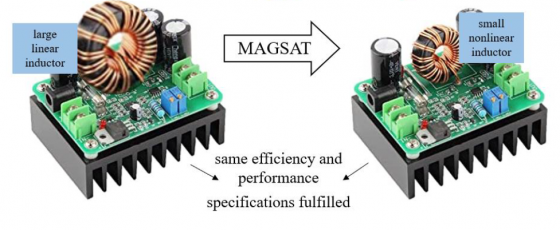
According to the European Green Deal, greenhouse gases emission should be reduced by at least 50% in 2030 compared to 1990 and should reach zero by 2050. About a quarter of the EU's greenhouse gas emissions is caused by transportation, which makes electrification of transport a priority. The last decade witnessed a huge growth of hybrid and full-electric cars, and more electric aircraft are paving the way for full-electric air transportation. In this context, switch-mode power supplies (SMPSs), converting input power at a given voltage and current level to output power at a different voltage and current level, are increasingly exploited to interface batteries, motors, and other electrical loads. Then, a high SMPS power density is of great importance, as smaller and lighter converters contribute to reducing the overall vehicle power consumption. The bulkiest component in SMPSs is the inductor, realized by winding a conductive wire around a core, typically made of ferrite. If the inductor core size is reduced, more windings are necessary to maintain the same inductance, possibly inducing magnetic saturation. As an alternative, high-permeability materials such as amorphous or nanocrystalline alloys can be used, having an extremely soft magnetic behavior and the possibility of customizing their magnetic properties with specific treatments.
Magnetic saturation is traditionally avoided in SMPS design, as the inductor behavior is strongly nonlinear, and power loss increases. However, recent studies showed that it is possible to reduce the inductor size up to 50% by allowing a partial saturation, with a negligible increase in power loss. This inspired researchers to develop behavioral models, relying on easy-to-measure quantities, able to mimic the inductor’s behavior also in partial saturation. Very recent surveys witness the growing interest in this research field. All these studies focus on small-size ferrite-core inductors, applied to low-power SMPSs. The possibility of exploiting amorphous- and nanocrystalline-core inductors in partial saturation to further reduce size has not been verified yet, and tests on medium-power SMPSs with bigger inductors would surely motivate researchers and companies to further study and exploit saturating inductors to increase power density. These aspects inspired the MAGSAT proposal.
Associated publications
Ravera, A., Oliveri, A., Lodi, M., Beatrice, C., Ferrara, E., Fiorillo, F., & Storace, M. (2024). Modeling Amorphous-core Inductors up to Magnetic Saturation. IEEE Transactions on Power Electronics.
Ravera, A., Formentini, A., Lodi, M., Oliveri, A., Passalacqua, M., & Storace, M. (2024). Modeling the Effect of Air-Gap Length and Number of Turns on Ferrite-Core Inductors Working up to Magnetic Saturation in a Buck Converter. IEEE Transactions on Circuits and Systems I: Regular Papers.
Firpo, P., Ravera, A., Oliveri, A., Lodi, M., & Storace, M. (2023). Use of a partially saturating inductor in a boost converter with model predictive control. Electronics, 12(14), 3013.
Ravera, A., Oliveri, A., Lodi, M., & Storace, M. (2023, July). A nonlinear behavioral model of a ferrite-core inductor with fixed-frequency sinusoidal voltage input. In IEEE EUROCON 2023-20th International Conference on Smart Technologies (pp. 418-422). IEEE.
Oliveri, A., Lodi, M., Beatrice, C., Ferrara, E., Storace, M., & Fiorillo, F. (2022, May). Behavioral model of an amorphous-core inductor working up to partial saturation. In 2022 IEEE International Symposium on Circuits and Systems (ISCAS) (pp. 1522-1526). IEEE.